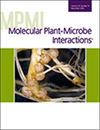求助PDF
{"title":"Differential Effects of Local dsRNA Application on Systemic Beet Mosaic Virus Resistance in <i>Nicotiana benthamiana</i> and <i>Beta vulgaris</i>.","authors":"Dennis Rahenbrock, Marieke Bode, Mark Varrelmann","doi":"10.1094/MPMI-01-25-0009-R","DOIUrl":null,"url":null,"abstract":"<p><p>Beet mosaic virus (BtMV) is one of several viruses infecting sugar beets and was previously managed by controlling the vector <i>Myzus persicae</i> with neonicotinoid seed treatment. Following the ban of this measure in 2019 in Europe, alternative control strategies needed to be researched. One alternative might be the use of RNA interference as a major antiviral defense system. Here, we report the selection of target regions using small RNA high-throughput sequencing of BtMV-infected <i>Beta vulgaris</i> subsp. <i>vulgaris</i> and <i>Nicotiana benthamiana</i> plants, the production of double-stranded RNA (dsRNA), and the effective use of dsRNA in inducing resistance against the mechanically inoculated virus under greenhouse conditions. In <i>Escherichia coli</i> HT115, the dsRNAs produced for BtMV P1 and nuclear inclusion body b (NIb) induced a high level of resistance when sprayed before mechanical BtMV inoculation, resulting in an 80% reduction of symptomatic <i>B. vulgaris</i> and <i>N. benthamiana</i> plants. Stem-loop RT-qPCR showed the systemic distribution of dsRNA-derived small interfering RNA molecules, but the applied dsRNA remained at the site of application and did not spread within the plant. However, when the virus was inoculated on the next upward leaf to the dsRNA application site, no protective effect was observed. Despite this limitation, the results demonstrate the potential of dsRNA as an effective tool for viral protection in sugar beets, thereby establishing a basis for future developments in systemic delivery and broader field applications. [Formula: see text] Copyright © 2025 The Author(s). This is an open access article distributed under the CC BY-NC-ND 4.0 International license.</p>","PeriodicalId":19009,"journal":{"name":"Molecular Plant-microbe Interactions","volume":" ","pages":"518-528"},"PeriodicalIF":3.4000,"publicationDate":"2025-07-01","publicationTypes":"Journal Article","fieldsOfStudy":null,"isOpenAccess":false,"openAccessPdf":"","citationCount":"0","resultStr":null,"platform":"Semanticscholar","paperid":null,"PeriodicalName":"Molecular Plant-microbe Interactions","FirstCategoryId":"99","ListUrlMain":"https://doi.org/10.1094/MPMI-01-25-0009-R","RegionNum":3,"RegionCategory":"生物学","ArticlePicture":[],"TitleCN":null,"AbstractTextCN":null,"PMCID":null,"EPubDate":"2025/8/5 0:00:00","PubModel":"Epub","JCR":"Q2","JCRName":"BIOCHEMISTRY & MOLECULAR BIOLOGY","Score":null,"Total":0}
引用次数: 0
引用
批量引用
Abstract
Beet mosaic virus (BtMV) is one of several viruses infecting sugar beets and was previously managed by controlling the vector Myzus persicae with neonicotinoid seed treatment. Following the ban of this measure in 2019 in Europe, alternative control strategies needed to be researched. One alternative might be the use of RNA interference as a major antiviral defense system. Here, we report the selection of target regions using small RNA high-throughput sequencing of BtMV-infected Beta vulgaris subsp. vulgaris and Nicotiana benthamiana plants, the production of double-stranded RNA (dsRNA), and the effective use of dsRNA in inducing resistance against the mechanically inoculated virus under greenhouse conditions. In Escherichia coli HT115, the dsRNAs produced for BtMV P1 and nuclear inclusion body b (NIb) induced a high level of resistance when sprayed before mechanical BtMV inoculation, resulting in an 80% reduction of symptomatic B. vulgaris and N. benthamiana plants. Stem-loop RT-qPCR showed the systemic distribution of dsRNA-derived small interfering RNA molecules, but the applied dsRNA remained at the site of application and did not spread within the plant. However, when the virus was inoculated on the next upward leaf to the dsRNA application site, no protective effect was observed. Despite this limitation, the results demonstrate the potential of dsRNA as an effective tool for viral protection in sugar beets, thereby establishing a basis for future developments in systemic delivery and broader field applications. [Formula: see text] Copyright © 2025 The Author(s). This is an open access article distributed under the CC BY-NC-ND 4.0 International license.
局部应用dsRNA对烟叶和甜菜系统性抗BtMV的差异效应
甜菜花叶病毒(BtMV)是甜菜感染的几种病毒之一,采用新烟碱类种子处理控制病媒桃蚜。继2019年欧洲禁止这一措施后,必须研究替代控制策略。另一种选择可能是使用RNA干扰(RNAi)作为主要的抗病毒防御系统。在这里,我们报告了用小RNA高通量测序的BtMV感染的普通β亚种的目标区域的选择。研究了双链RNA (dsRNA)的产生及其在诱导对机械接种病毒的抗性中的有效应用。HT115在大肠杆菌中都产生了BtMV P1和核包含体b (NIb)的dsRNAs,在机械接种BtMV之前喷洒,导致有症状的b . vulgaris和N. benthamiana植物减少80%。茎环RT-qPCR显示了dsRNA衍生的siRNA分子的系统性分布,但所施用的dsRNA仍停留在施用部位,并未在植株内扩散。然而,当病毒在第二个向上的叶片上接种到dsRNA应用位点时,没有观察到保护作用。尽管存在这些限制,但研究结果表明,dsRNA作为甜菜病毒保护的有效工具具有潜力,从而为未来系统递送和更广泛的田间应用奠定了基础。
本文章由计算机程序翻译,如有差异,请以英文原文为准。

 求助内容:
求助内容: 应助结果提醒方式:
应助结果提醒方式:


